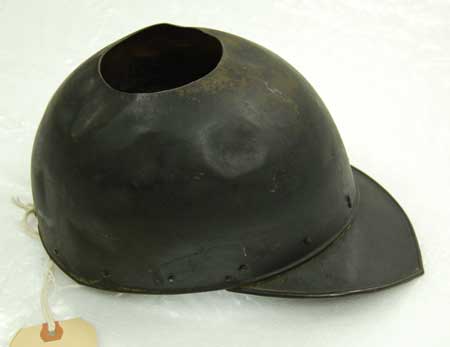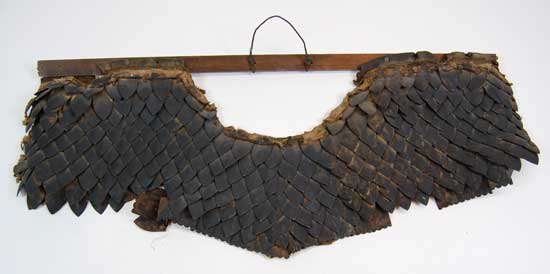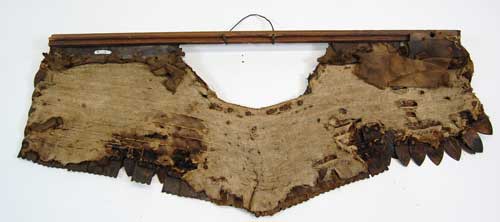It looks like you're using an Ad Blocker.
Please white-list or disable AboveTopSecret.com in your ad-blocking tool.
Thank you.
Some features of ATS will be disabled while you continue to use an ad-blocker.
10
share:
I just ran across this very interesting piece at WesternDigs.org
The Bourke armor was supposedly found on the remains of a man in the west Texas desert, 150 years ago, by a US cavalry officer,Capt. John Bourke.

The helmet


the gorget
More of the story
The assumption is the armor is Spanish, that would be the most likely scenario as it dates to the appropriate period.
It's too bad the breast plate and back were lost as they would shed more light on where this came from.
The dating puts it in the 17th century, a time before more modern ways of smelting iron became common, it is made from hand smelted bloomery iron, something not is use in the 19th century US.
They go on to theorize that the armor might have been a Freemason costume, but I think that is highly unlikely, given where it was found, west Texas was not a very friendly place in those days.
Another thing that stumps the researchers is the cotton twill of the backing,
Western Digs-Bourke Armor
In my youth I was somewhat of a arms and armor buff, I even made a replica of a 16th century Japanese suit, as a high school metal shop project, so I'm a little familiar with what types of armor one would find where and when.
This set is certainly out of place in colonial Spanish territory, of the 1600's, but would not have been unheard of in the early 1500's, as it could have been passed down through a conquistadors family before coming to the new world, but the helmet is not what you would find a Spaniard wearing at that time.
The pattern of the helmet is what one would find on a 17th century northern European (English or dutch) cavalry soldier, but the giant hole in the top, combined with the bloomer iron, cotton backing and black coloring, screams Japanese to me.
The hole in the top of the helmet is for the top knot, and the Japanese used cotton to back up their armor and scales were still in use on some suits into the 19th century.
One thing to remember is that the cotton and scales might not be from the same period. An older suit could have been refurbished with more recent cotton.
The Bourke armor was supposedly found on the remains of a man in the west Texas desert, 150 years ago, by a US cavalry officer,Capt. John Bourke.
It seems to have passed through more hands than The Maltese Falcon. And it’s proving to be nearly as mysterious.
Two pieces of iron armor — reportedly first found in the desert of West Texas about 150 years ago — have recently been analyzed by scientists in Nebraska, where the artifacts have been sitting for decades in museum storage.
Archaeologists have been able to determine that some of the armor’s components are at least 200 years old, but details about who made it, who wore it, and where exactly it came from remain a total mystery.
“I don’t know where this thing came from,” said Dr. Peter Bleed, a University of Nebraska archaeologist who led the study.

The helmet


the gorget
More of the story
The few records of the armor that exist came from U.S. cavalry officer and anthropologist Capt. John Gregory Bourke, who was given the gorget, helmet, and a breast- and backplate in 1870, from an army doctor who claimed to have found them “enclosing the bones of a man in the arid country between the waters of the Rio Grande and the Pecos.”
Bourke took the armor with him from post to post throughout the West during his career, losing the breast and backplates to thieves in Arizona along the way.
But before his death in 1896, Bourke gave the helmet and gorget to a judge’s wife in Nebraska, and by the early 20th century, it was in the possession of an Omaha attorney, in whose family it remained until it was donated to a museum in 1961, and then to the state historical society.
The assumption is the armor is Spanish, that would be the most likely scenario as it dates to the appropriate period.
Historical records describe the equipment used by Spanish soldiers at that time, but the team found that it included little armor, the Spanish instead having used mostly padded leather or shirts of chain mail.
“It just is not very much like armor known to have been used by colonial Spanish forces,” Bleed said of Bourke’s armor of iron scales.
“The Spanish apparently had some (chain) mail, but the idea of taking a fabric and attaching little fish scales to it, this is not something they did.”
It's too bad the breast plate and back were lost as they would shed more light on where this came from.
The dating puts it in the 17th century, a time before more modern ways of smelting iron became common, it is made from hand smelted bloomery iron, something not is use in the 19th century US.
There, analysis revealed that the iron in the armor contained unusually high amount of slag — impurities like clay, quartz, and other non-metallic rock.
This high slag content is the signature of an early smelting process known as bloomery, and it’s further evidence of the armor’s age, the team said.
Bloomery was obsolete in the U.S. and Europe by the early 1800s, having been replaced by more refined smelting techniques. So the amount of bloomery iron being produced in the U.S. and Europe was “minuscule” by the middle of the nineteenth century, the team noted.
They go on to theorize that the armor might have been a Freemason costume, but I think that is highly unlikely, given where it was found, west Texas was not a very friendly place in those days.
Another thing that stumps the researchers is the cotton twill of the backing,
“I was surprised that there was a lot of cotton in the armor along with pre-blast furnace, or bloomery, iron in the armor,” Bleed said.
“People tend to think of cotton as something that got big after the gin and that is often treated as a 1830s, 1840s development.
“But by that time, bloomery iron was not being produced – at least in Europe and the U.S.
“That makes the combination of material somewhat surprising.”
Western Digs-Bourke Armor
In my youth I was somewhat of a arms and armor buff, I even made a replica of a 16th century Japanese suit, as a high school metal shop project, so I'm a little familiar with what types of armor one would find where and when.
This set is certainly out of place in colonial Spanish territory, of the 1600's, but would not have been unheard of in the early 1500's, as it could have been passed down through a conquistadors family before coming to the new world, but the helmet is not what you would find a Spaniard wearing at that time.
The pattern of the helmet is what one would find on a 17th century northern European (English or dutch) cavalry soldier, but the giant hole in the top, combined with the bloomer iron, cotton backing and black coloring, screams Japanese to me.
The hole in the top of the helmet is for the top knot, and the Japanese used cotton to back up their armor and scales were still in use on some suits into the 19th century.
One thing to remember is that the cotton and scales might not be from the same period. An older suit could have been refurbished with more recent cotton.
That's actually pretty interesting. It could very well be just a hodgepodge of armor used by someone. The story behind this armor is probably the most
interesting aspect. Who was this person? Why were they in the desert wearing it? What was the motivation behind using it?
My theory, it could have been a spanish-indian descendent with some conquistador heirlooms. The mail reminds me of an aztec feather piece worn on the shoulders. Maybe a small clan of mixed people had passed down knowledge of metal work from the spanish days and this is a isolated fusion of the two cultures from a small tribe.
Very interesting though.
My theory, it could have been a spanish-indian descendent with some conquistador heirlooms. The mail reminds me of an aztec feather piece worn on the shoulders. Maybe a small clan of mixed people had passed down knowledge of metal work from the spanish days and this is a isolated fusion of the two cultures from a small tribe.
Very interesting though.
a reply to: punkinworks10
wow! this made me think of H.P Lovecraft`s story "the mound" , in this story, there are native american characters, that wear pieces of armor, that they should not have, at least in mainstream history,
real good read, and with this awesome find, even better.
wow! this made me think of H.P Lovecraft`s story "the mound" , in this story, there are native american characters, that wear pieces of armor, that they should not have, at least in mainstream history,
real good read, and with this awesome find, even better.
a reply to: sirChill
That was my first impression, it looked more like feathers than fish scales and reminded me of armor I have seen from Central America. I thought it looked like a native copying what he had seen on Europeans. The hole in the helmet could be to save metal. But where it was found is a more interesting story to me too. My other thought too was that it could be from two different sources. Cotton was native to America, Africa and India, but African cotton dominated world production pretty quickly, so the species of cotton would be interesting to find out.
That was my first impression, it looked more like feathers than fish scales and reminded me of armor I have seen from Central America. I thought it looked like a native copying what he had seen on Europeans. The hole in the helmet could be to save metal. But where it was found is a more interesting story to me too. My other thought too was that it could be from two different sources. Cotton was native to America, Africa and India, but African cotton dominated world production pretty quickly, so the species of cotton would be interesting to find out.
a reply to: punkinworks10
The helmet looks similar to those from the English Civil War period (although modified), the armour looks earlier though and more Spanish / Basque. Does that suggest a mercenary? Someone who has served in various places and picked up bits here and there.
The helmet looks similar to those from the English Civil War period (although modified), the armour looks earlier though and more Spanish / Basque. Does that suggest a mercenary? Someone who has served in various places and picked up bits here and there.
originally posted by: Marduk
Why, that could almost be...
remingtons.files.wordpress.com...
If the scales were sewn into spandex, I would be thoroughly convinced.
Visually it is a match.
originally posted by: Flavian
a reply to: punkinworks10
The helmet looks similar to those from the English Civil War period (although modified), the armour looks earlier though and more Spanish / Basque. Does that suggest a mercenary? Someone who has served in various places and picked up bits here and there.
Yes, the helmet does look very much like what one would find in the English civil war, or by dutch calvalry.
I think it is a hodge podge of items put together from second hand stuff, and the scales are much older than the rest.
new topics
-
Putin, Russia and the Great Architects of the Universe
ATS Skunk Works: 43 minutes ago -
A Warning to America: 25 Ways the US is Being Destroyed
New World Order: 5 hours ago -
President BIDEN's FBI Raided Donald Trump's Florida Home for OBAMA-NORTH KOREA Documents.
Political Conspiracies: 10 hours ago
top topics
-
President BIDEN's FBI Raided Donald Trump's Florida Home for OBAMA-NORTH KOREA Documents.
Political Conspiracies: 10 hours ago, 28 flags -
A Warning to America: 25 Ways the US is Being Destroyed
New World Order: 5 hours ago, 10 flags -
Gaza Terrorists Attack US Humanitarian Pier During Construction
Middle East Issues: 17 hours ago, 8 flags -
Las Vegas UFO Spotting Teen Traumatized by Demon Creature in Backyard
Aliens and UFOs: 16 hours ago, 7 flags -
2024 Pigeon Forge Rod Run - On the Strip (Video made for you)
Automotive Discussion: 16 hours ago, 4 flags -
Is AI Better Than the Hollywood Elite?
Movies: 12 hours ago, 3 flags -
Maestro Benedetto
Literature: 12 hours ago, 1 flags -
Putin, Russia and the Great Architects of the Universe
ATS Skunk Works: 43 minutes ago, 1 flags
active topics
-
What in the S.E.O. hell is this?
General Chit Chat • 27 • : reannamurphy -
Putin, Russia and the Great Architects of the Universe
ATS Skunk Works • 7 • : RussianTroll -
"We're All Hamas" Heard at Columbia University Protests
Social Issues and Civil Unrest • 286 • : FlyersFan -
A Warning to America: 25 Ways the US is Being Destroyed
New World Order • 9 • : Lazy88 -
President BIDEN's FBI Raided Donald Trump's Florida Home for OBAMA-NORTH KOREA Documents.
Political Conspiracies • 21 • : CriticalStinker -
SETI chief says US has no evidence for alien technology. 'And we never have'
Aliens and UFOs • 75 • : Hecate666 -
Las Vegas UFO Spotting Teen Traumatized by Demon Creature in Backyard
Aliens and UFOs • 13 • : FlyersFan -
Mood Music Part VI
Music • 3105 • : BrucellaOrchitis -
The Acronym Game .. Pt.3
General Chit Chat • 7752 • : bally001 -
Is AI Better Than the Hollywood Elite?
Movies • 18 • : Hecate666
10
